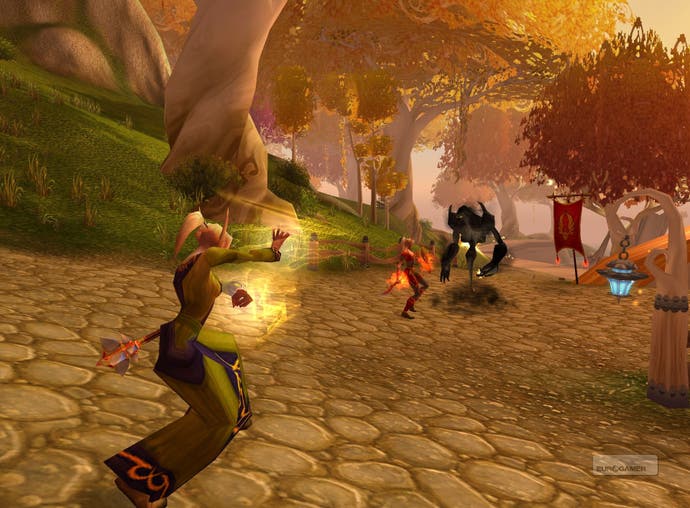The Making of World of Warcraft
Part Two: Five years at the top.
It wasn't just the setting that was off the wall. One of Brack's favourite innovations in Burning Crusade was the invention of bombing run quests, which send the player on flying sorties over enemy territory. "That just started out as a crazy idea," he recalls. "Some guys made this bombing run, and I saw that and just felt, holy crap, this is amazing. It's the first time that you get to kill hundreds of units all by yourself - you feel very powerful. It's an awesome, epic moment."
Tom Chilton, too, viewed the expansion as an opportunity to make radical changes - changes he'd debated for a long time, as some of the flaws inherent in WOW's Battlegrounds and PvP honour system became apparent to him.
"The honour system was one of those things where I think we made a mistake in our original philosophies," he admits. "Both Rob [Pardo, Blizzard's design chief] and I had pretty strong feelings that we didn't want just a grind-based system, a system that was based entirely on time investment. We wanted to be able to rank PvPers based on success."
It didn't work, because the team didn't want to punish players for being "ganked" - dispatched by far more powerful opponents. Just as WOW doesn't subtract experience when you die, it doesn't subtract honour when you are killed by another player, because the game has no way of knowing if it was a fair fight. As a result, Chilton acknowledges, "it turned into a competitive grind, meaning that time investment still mattered the most. On a weekly basis, it was a question of how much more time you could put in than the other person.

"We ended up realising that, OK, we really need to separate the competitive system from the grind system - we can't try to jam those into the same system. That's how the Arena system evolved, with the chess-style rating system where we really control the scenario. We were able to use that as the measurement of skill in PvP, while we could use Battlegrounds as the fun activity that you could grind out points in and get stuff."
The launch of the Burning Crusade on January 16th, 2007, confirmed just how insanely popular World of Warcraft had become. Over 2.4 million copies were sold in the first 24 hours after its launch, stretching to over 3.5 million within the first month in Europe, North America and Australasia alone. At the time, it was the fastest-selling computer game ever - a record it would hold for almost two years.
Nonetheless, the same in-depth post-mortem process which Brack had witnessed in operation on Ahn'Qiraj and Naxxramas was brought to bear on The Burning Crusade, and the team found plenty of room for improvement. Some of the things they learned would have an impact on the next expansion pack. Others, however, caused more urgent problems.

One of those things was the immense and almost immediate success of Karazhan, a ten-player dungeon which was launched as part of The Burning Crusade. The team had debated hotly the decision to drop the raid size from 40 to 25 in the expansion, with this smaller dungeon a mere afterthought. As it turned out, the sweet spot for many players was neither 40 nor 25 - it was ten.
"We were very surprised by the success of Karazhan," admits Brack. "It's probably one of the most popular pieces of content, just in terms of number of players that have experienced it, that we've ever done."
That success upset the team's plans to push ahead with 25-man raids, in the form of the massive Black Temple, but it was too late to change course. "We made a mistake in releasing Black Temple when we did," says Brack. "If we could wave the magic wand and go back, we would have released ten-man Zul'Aman, and then Black Temple afterwards."
